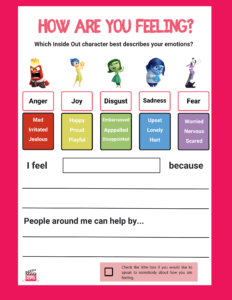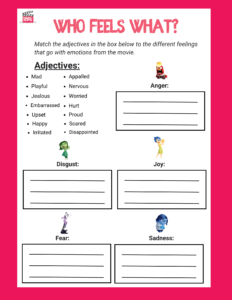Inside Out Worksheet
Pixar's critically acclaimed film "Inside Out" stands as an extraordinary tool for teaching children about the nuanced world of emotions. The movie's ingenious depiction of characters embodying different emotions presents an opportunity for children to understand the inherent complexity of feelings, their roles, and their invaluable contribution to shaping our lives.
Each character in the movie represents an emotion; Joy, Sadness, Anger, Fear, and Disgust. This diverse emotional lineup allows children to comprehend that the spectrum of human emotions is wide and complex. It goes beyond the simplistic binary of good and bad emotions. Joy, with her sunny demeanor and infectious positivity, embodies the significance of happiness in our lives. She is the symbol of positivity, demonstrating the potential of happiness to make our experiences enjoyable and worthwhile. Meanwhile, the character of Sadness, through her journey, conveys the message that it's okay to feel sad. Processing challenging emotions such as sorrow is not only natural but also essential for personal growth and resilience.
The interplay of these diverse emotions throughout the film illustrates the delicate balance required in managing our emotional lives. It helps children grasp the idea that our emotions are not isolated entities; rather, they work in conjunction to make us who we are. This encourages children to acknowledge, respect, and express their emotions, promoting their emotional intelligence and well-being.
The movie "Inside Out" is a springboard to initiate crucial conversations with children about their emotions. Children can learn to identify their feelings and understand their experiences in relation to what the characters in the film go through. Such conversations can equip them with the skills to better understand, express, and cope with their feelings, ultimately fostering their emotional health.
Furthermore, the film's educational value is enhanced by the availability of "Inside Out" worksheets on websites like teacherspayteachers.com. These worksheets can add an engaging, interactive element to the learning experience, thereby making it more enjoyable and impactful. For instance, my wife, a second-grade teacher, and I have created a series of worksheets based on the movie, available for free download. The worksheets can help children identify and articulate their feelings. They align with core concepts in early education, such as the use of adjectives, making them useful resources for other educators as well.
How Are You Feeling?

Download Now
The first worksheet is an exercise to correlate how one is feeling to a character from the movie. By associating their feelings with these characters, children can more easily recognize their emotions and put them into words.
Explaining why they feel a certain way helps to develop their emotional intelligence. It promotes self-awareness and enables them to understand the triggers for their emotions, whether it's a challenging situation at school or an exciting event. By learning to identify and express their feelings, children are better equipped to manage their emotional reactions in a healthy way.
This Inside Out Worksheet encourages children to think about how others can help them navigate their feelings. This fosters empathetic thinking as they consider the role others play in their emotional wellbeing. Additionally, it also improves their communication skills, as they learn to express their needs to their parents, teachers, or peers, promoting better understanding and support within their community.
Lastly, integrating an entertaining and popular movie like "Inside Out" ensures that the process is enjoyable for children, making them more likely to engage and participate. This combination of fun and learning facilitates deeper emotional comprehension, making it a vital tool in fostering emotional literacy.
Who Feels What?

Download Now
The second worksheet involves an activity where students must determine why a certain character is experiencing a particular emotion, serving as an engaging way to employ adjectives.
Using well-recognized and emotionally expressive characters from the movie, children can associate these characters with specific adjectives, reinforcing their understanding and ability to use these descriptive words in context.
The exercise of linking adjectives to familiar characters makes the learning process enjoyable and more meaningful. When children see Joy, Sadness, Anger, Fear, and Disgust, they can link these characters with descriptive adjectives such as 'happy', 'gloomy', 'furious', 'frightened', and 'disgusted', thereby vividly picturing and deeply understanding the meaning and use of these words.
The worksheet further strengthens the learning process by encouraging children to explain their understanding of these adjectives. This active engagement facilitates a deeper comprehension of the adjectives and provides an opportunity to practice articulating their thoughts, thereby improving their communication skills. Additionally, it helps children understand how these adjectives are applicable in everyday life, developing their ability to describe their own emotions and experiences accurately. This understanding not only enhances their language and literacy skills, but also promotes emotional intelligence.
"Inside Out" is more than just an entertaining movie; it is a rich, vibrant, and accessible emotional education resource. Its nuanced and empathetic portrayal of emotions, coupled with engaging teaching tools like worksheets, can profoundly impact children's understanding of their emotions, equipping them with the knowledge and skills to navigate their emotional lives effectively.

